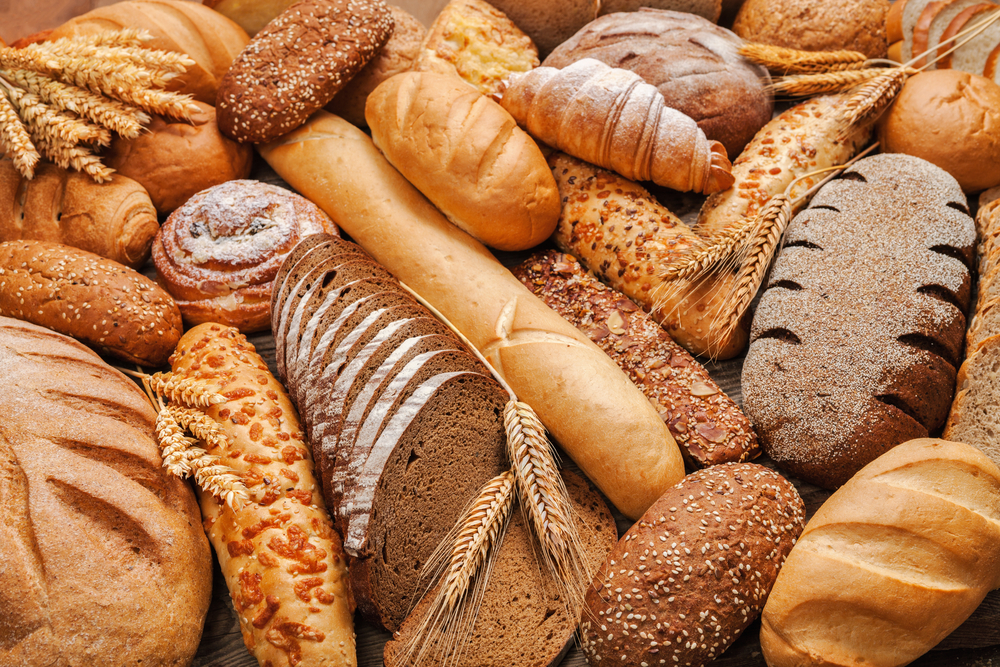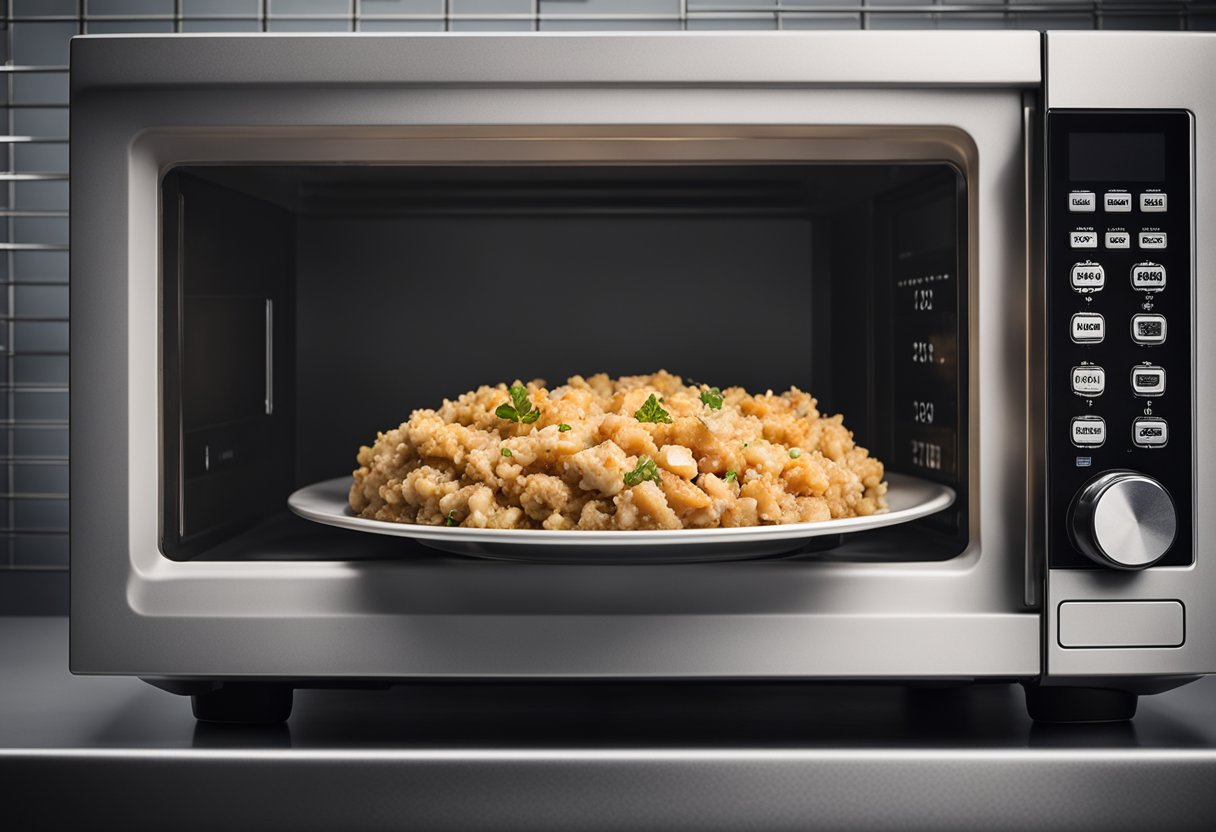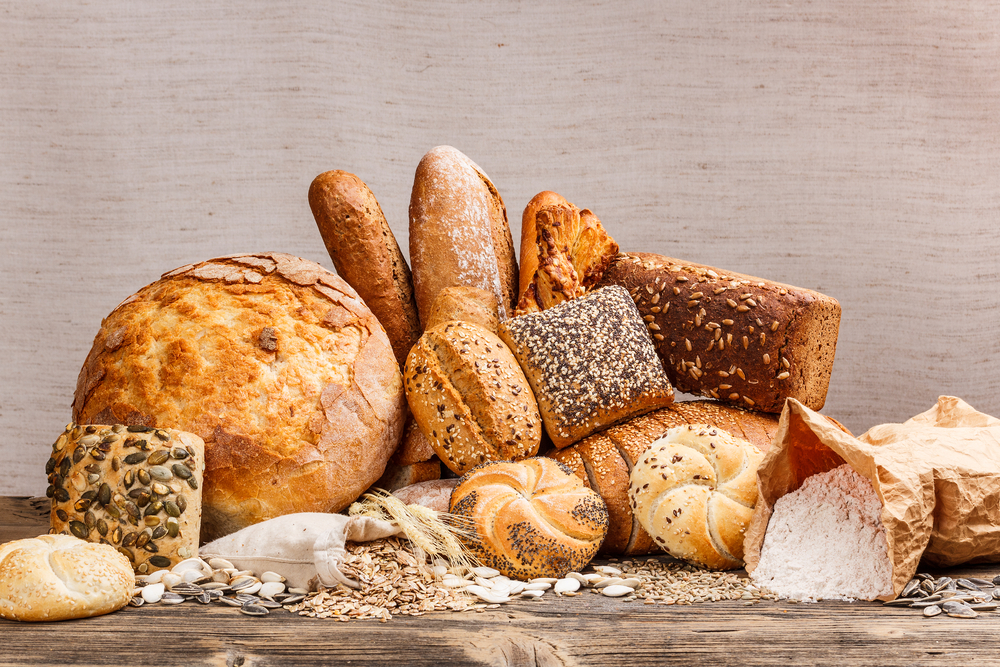When it comes to Thanksgiving leftovers, stuffing is one of the dishes that tends to get overlooked. However, with a little bit of effort, you can easily turn leftover stuffing into a delicious meal.
The trick is to reheat it properly to maintain its texture and flavor. In this article, I will share the best way to reheat stuffing so that it tastes just as good as it did on Thanksgiving Day.
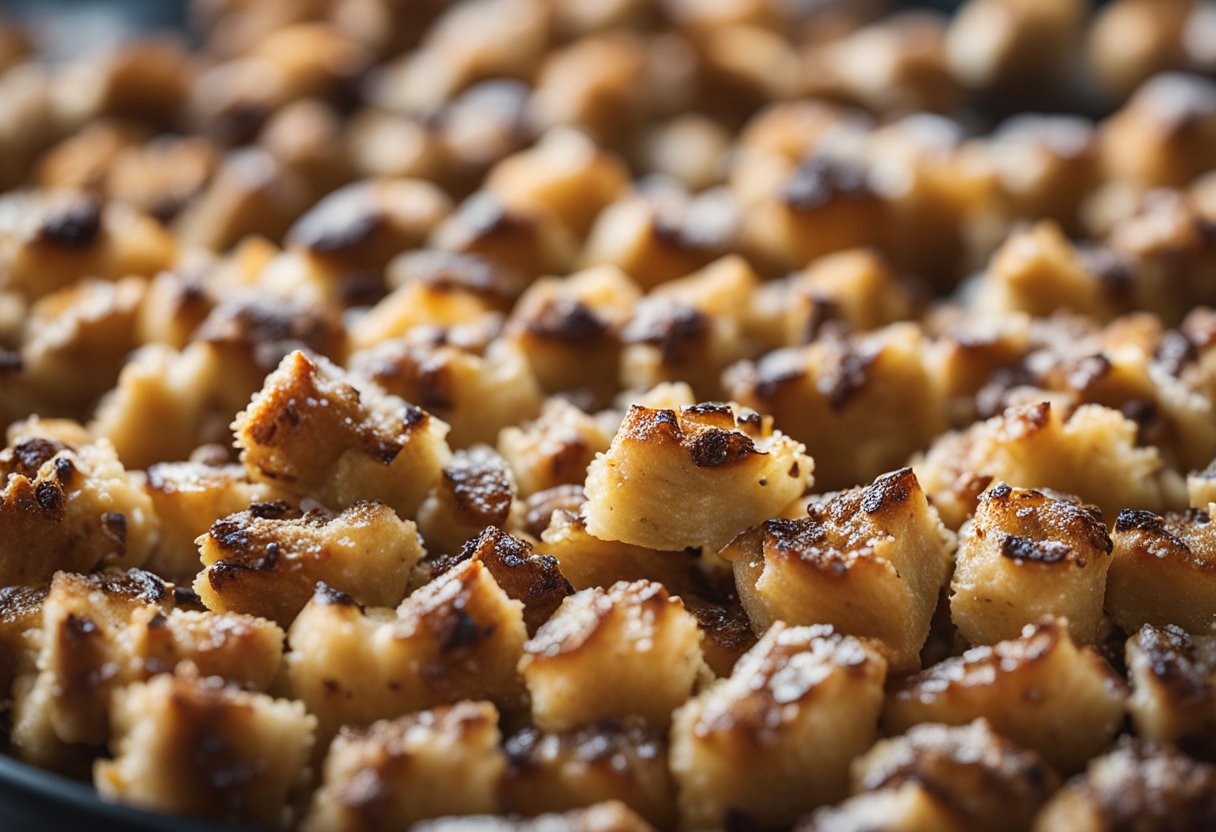
Understanding stuffing is crucial to reheating it properly. Stuffing is made with bread, herbs, and other ingredients that are mixed together and baked in the oven.
The bread absorbs the moisture from the other ingredients, which is what gives stuffing its unique texture. When reheating stuffing, it’s important to maintain that moisture to prevent it from becoming dry and flavorless.
Preserving leftover stuffing is the first step to reheating it properly. You should store leftover stuffing in an airtight container in the refrigerator for up to four days.
If you plan to keep it longer, freeze it for up to three months. When it’s time to reheat the stuffing, there are a few methods you can use to ensure that it stays moist and delicious.
Understanding Stuffing
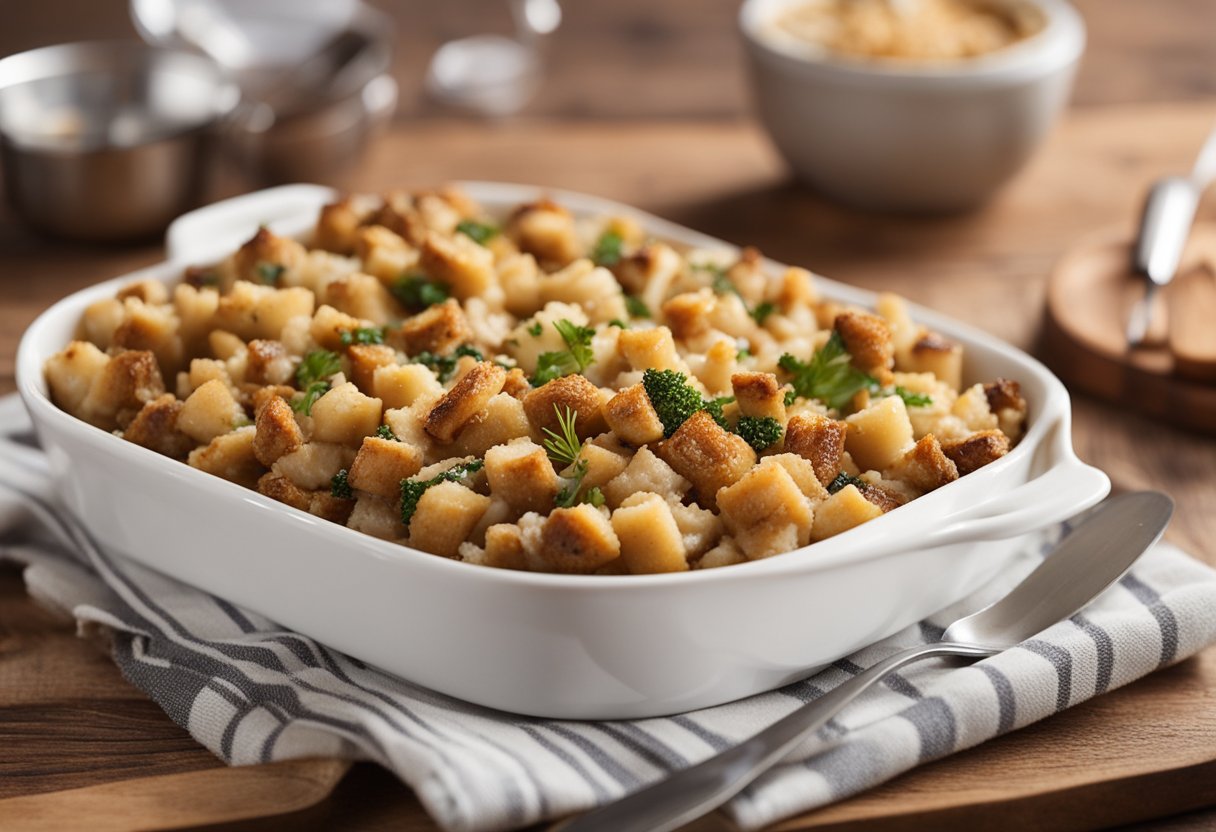
Stuffing is a classic side dish that is often served during holiday meals like Thanksgiving and Christmas. It is made by combining various ingredients and then stuffing them into a poultry or seafood cavity or baking dish.
In this section, I will discuss the ingredients of stuffing, the significance of stuffing, and health considerations to keep in mind.
Ingredients of Stuffing
The ingredients of stuffing can vary depending on the recipe and the cook’s preferences. However, some common ingredients include bread, celery, onions, butter, sage, and spices.
Some recipes also include fruits like apples or cranberries and nuts like pecans or walnuts.
The bread used in stuffing can be any type of bread, but it is usually stale or dried out bread that is cut into small cubes.
The celery and onions are typically sautéed in butter before being mixed with the bread. Sage and other spices are added to give the stuffing its signature flavor.
Significance of Stuffing
Stuffing is an important part of holiday meals, especially Thanksgiving dinner. It is often served alongside the main dish, which is usually turkey or ham.
Stuffing adds flavor and texture to the meal, and it is a traditional dish that many people look forward to each year.
In addition to its culinary significance, stuffing also has cultural significance. It is a dish that has been enjoyed for centuries and is a symbol of family, tradition, and togetherness.
Health Considerations
While stuffing is a delicious and traditional dish, it is important to keep in mind some health considerations when preparing and consuming it.
Stuffing can be high in calories, fat, and sodium, especially if it contains a lot of butter and salt.
To make stuffing healthier, consider using whole grain bread and reducing the amount of butter and salt. You can also add more vegetables like carrots or bell peppers to increase the nutritional value of the dish.
In conclusion, stuffing is a classic side dish that is enjoyed by many during holiday meals.
Understanding the ingredients of stuffing, its significance, and health considerations can help you make informed decisions when preparing and consuming this dish.
Preserving Leftover Stuffing
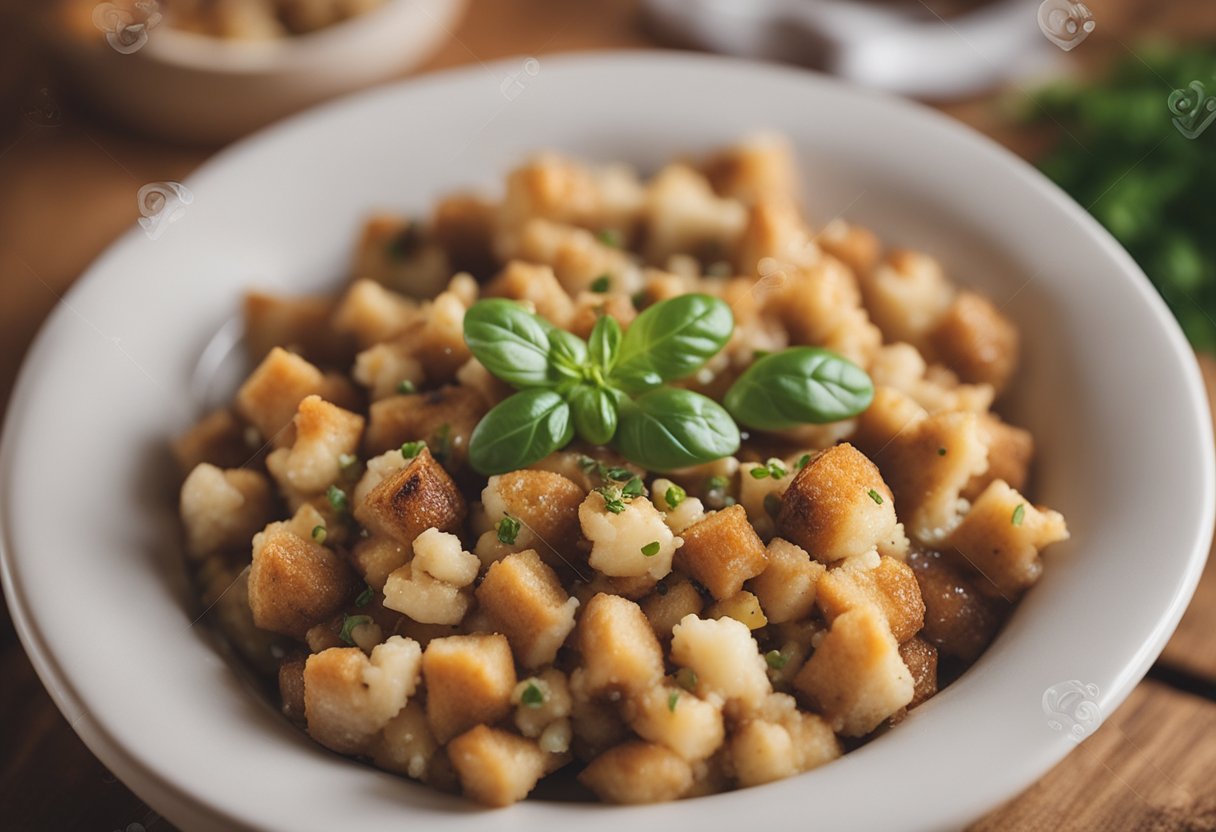
As much as I enjoy stuffing, I can never finish the entire batch in one sitting. That’s why I always find myself with leftover stuffing after Thanksgiving dinner.
Fortunately, there are a few ways to preserve leftover stuffing so that it can be enjoyed later.
Refrigerating Leftover Stuffing
If you plan on eating your leftover stuffing within a few days, then refrigerating it is the way to go. To do this, simply place the stuffing in an airtight container and store it in the refrigerator.
The stuffing should last for up to four days in the fridge.
It’s important to note that you should avoid leaving the stuffing out at room temperature for too long before refrigerating it. Bacteria can grow rapidly in cooked food that is left out for an extended period of time, which can lead to foodborne illness.
Freezing Leftover Stuffing
If you don’t plan on eating your leftover stuffing within a few days, then freezing it is the best option. Freezing leftover stuffing is a great way to preserve it for future meals.
To freeze leftover stuffing, simply wrap it tightly in plastic wrap or aluminum foil and place it in an airtight container or freezer bag. Make sure to label the container with the date so that you know when it was frozen.
When you’re ready to eat the frozen stuffing, simply thaw it in the refrigerator overnight. You can then reheat it using one of the methods outlined in the search results.
It’s important to note that frozen stuffing should be consumed within three to four months for optimal quality. After this time, the stuffing may start to lose its flavor and texture.
In summary, there are two ways to preserve leftover stuffing: refrigerating it for up to four days or freezing it for up to three to four months. By following these simple steps, you can enjoy your leftover stuffing without worrying about it going bad.
Reheating Stuffing
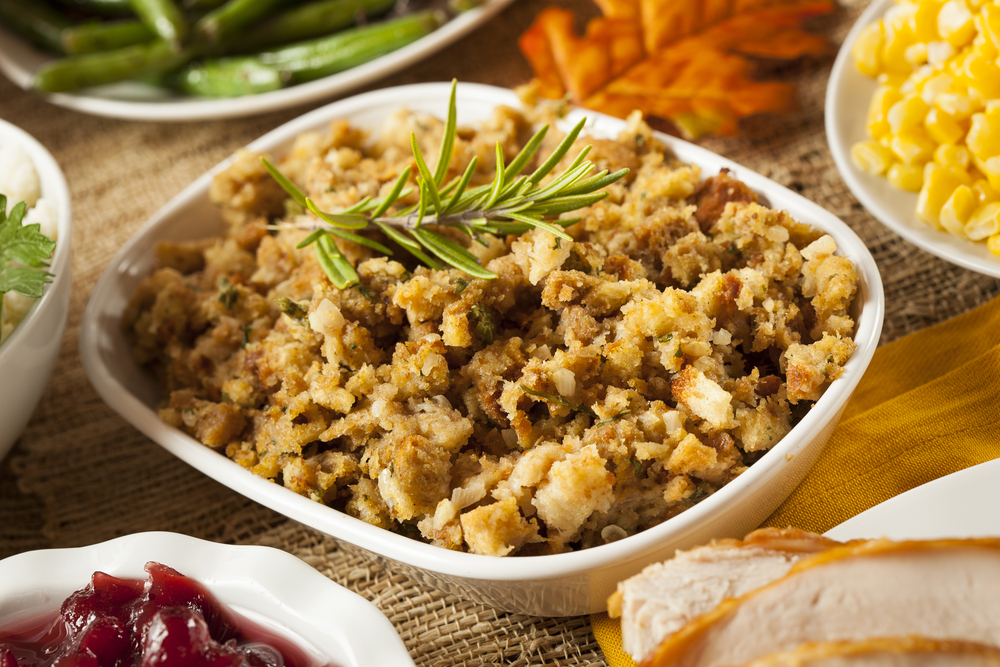
When it comes to reheating leftover stuffing, there are several methods you can use to get it warm and delicious again. Here are the four fastest ways to reheat stuffing:
Reheating in the Oven
To reheat stuffing in the oven, preheat the oven to 350°F and transfer the stuffing to an oven-safe dish. Cover the dish with aluminum foil and bake until the stuffing reaches an internal temperature of 165°F.
This should take about 20-30 minutes. If you want the top of the stuffing to be golden-brown and crispy, remove the foil for the last 5-10 minutes of baking.
Reheating on the Stovetop
Reheating stuffing on the stovetop is a great option if you want to keep an eye on it and stir it frequently. To do this, add a little oil and broth to a skillet and heat over medium heat.
Add the stuffing and stir frequently until it’s heated through. This should take about 10-15 minutes.
Reheating in the Microwave
If you’re short on time, reheating stuffing in the microwave is the quickest and easiest method. To do this, transfer the stuffing to a microwave-safe dish or plate and cover it with a damp paper towel.
Microwave on high for 1-2 minutes, or until the stuffing is heated through. Stir the stuffing halfway through cooking to ensure that it heats evenly.
Reheating in the Air Fryer
If you want your leftover stuffing to be crispy and crunchy, reheating it in the air fryer is a great option. To do this, preheat your air fryer to 350°F and transfer the stuffing to an air fryer basket.
Cook for 5-10 minutes, or until the stuffing is heated through and crispy.
No matter which method you choose, be sure to check the internal temperature of the stuffing to ensure that it has reached 165°F before serving. Enjoy your reheated stuffing!
Maintaining Moisture While Reheating
Reheating stuffing can be a bit tricky, as it tends to dry out quickly. To prevent this from happening, it’s essential to maintain moisture while reheating. Here are a few methods that I use to keep my stuffing moist and delicious:
Using Broths and Stocks
One of the best ways to add moisture to your stuffing while reheating is by using broths and stocks. Chicken broth and vegetable stock are excellent options that add flavor and moisture to your stuffing.
To use this method, simply pour a small amount of broth or stock over your stuffing before reheating it. You can also place your stuffing in a baking dish and pour the broth or stock over it, covering it with foil before reheating in the oven.
Using Butter and Oil
Another great way to maintain moisture while reheating stuffing is by using butter and oil. Adding a small amount of butter or oil to your stuffing before reheating can help prevent it from drying out.
To use this method, simply toss your stuffing with a small amount of melted butter or oil before reheating it. You can also drizzle the butter or oil over your stuffing before reheating it in the oven.
It’s important to note that while adding butter and oil can help keep your stuffing moist, it can also add extra calories and fat. So, use this method in moderation.
By using broths and stocks or adding butter and oil, you can maintain moisture in your stuffing while reheating it. These methods are easy, effective, and can help make your reheated stuffing taste just as good as it did on the first day.
Serving Reheated Stuffing
When it comes to serving reheated stuffing, there are a few things to keep in mind to ensure that it is just as delicious as when it was first made.
In this section, I will cover some tips and ideas for pairing reheated stuffing with sides and adding extra toppings.
Pairing with Sides
Reheated stuffing is a classic side dish that pairs well with a variety of other holiday favorites. One popular pairing is with mashed potatoes and gravy.
The creamy texture of the mashed potatoes complements the savory flavors of the stuffing, while the gravy adds a touch of richness.
Another great pairing is with cranberry sauce. The sweet and tangy flavors of the cranberry sauce provide a nice contrast to the savory stuffing. Plus, the vibrant red color of the sauce adds a pop of color to your plate.
If you’re looking for a healthier option, consider serving your reheated stuffing with a side salad. The fresh greens and veggies will help balance out the richness of the stuffing, while providing some extra nutrients.
Adding Extra Toppings
While stuffing is delicious on its own, adding some extra toppings can take it to the next level. One simple idea is to sprinkle some salt over the top of the reheated stuffing. This will enhance the flavors and make them more pronounced.
Another option is to add some extra herbs or spices. Sage, thyme, and rosemary are all classic herbs that pair well with stuffing. You can also experiment with other spices like paprika or cumin to add some extra depth of flavor.
If you’re feeling indulgent, consider adding some extra toppings like crispy bacon, toasted nuts, or dried fruit. These will add some extra texture and flavor to your stuffing, making it even more delicious.
Overall, serving reheated stuffing is a great way to enjoy a classic holiday dish without having to spend hours in the kitchen. By pairing it with sides and adding extra toppings, you can create a delicious and satisfying meal that everyone will love.
Conclusion
In conclusion, reheating stuffing is a simple process that can be done in a variety of ways. The best method for reheating stuffing depends on your personal preferences and the tools you have available.
If you want to maintain the texture and flavor of the stuffing, reheating it in the oven is the best option. Cover the dish with foil and bake it at 350°F until it is heated through. You can also add a little chicken or turkey broth to keep it moist.
If you are short on time, reheating stuffing in the microwave is a quick and easy option. Place the stuffing in a microwave-safe dish and heat it on high for 1-2 minutes, stirring occasionally.
Another option is to reheat stuffing on the stovetop. This method is great if you want to add a little extra flavor. Heat a tablespoon of oil in a large skillet over medium-high heat.
Add the stuffing and flatten it with the back of a spoon, making a pancake. Cook until golden brown, 3 to 5 minutes on each side.
No matter which method you choose, make sure the stuffing is heated to an internal temperature of 165°F to ensure that it is safe to eat.
In summary, reheating stuffing is a simple process that can be done in the oven, microwave, or stovetop. Choose the method that works best for you and enjoy your delicious leftovers!
Frequently Asked Questions
What is the recommended temperature to reheat stuffing in the oven?
The recommended temperature to reheat stuffing in the oven is 350°F. Preheat your oven to this temperature and transfer the stuffing to an oven-safe dish.
Cover the dish with foil to prevent it from drying out and bake until the stuffing is warmed through. This should take around 15-30 minutes depending on the amount of stuffing you are reheating.
What is the best way to reheat stuffing without drying it out?
The best way to reheat stuffing without drying it out is to add a little bit of liquid to it before reheating. You can use chicken or turkey broth, or even just a bit of water.
Add the liquid to the stuffing and mix well, then transfer it to an oven-safe dish. Cover the dish with foil and bake until the stuffing is warmed through.
Can you reheat stuffing in an air fryer?
Yes, you can reheat stuffing in an air fryer. Preheat your air fryer to 350°F and transfer the stuffing to an oven-safe dish or an air fryer basket.
Cover the dish or basket with foil to prevent it from drying out and air fry for 10-15 minutes, or until the stuffing is warmed through.
What is the best way to reheat frozen stuffing?
The best way to reheat frozen stuffing is to thaw it in the refrigerator overnight, then reheat it in the oven. Preheat your oven to 350°F and transfer the stuffing to an oven-safe dish.
Cover the dish with foil and bake until the stuffing is warmed through. This should take around 30-45 minutes depending on the amount of stuffing you are reheating.
Is it safe to eat cold leftover stuffing?
It is safe to eat cold leftover stuffing, but it may not taste as good as when it is reheated. If you do choose to eat cold leftover stuffing, make sure it has been stored properly in the refrigerator and has not been left out at room temperature for more than two hours.
How long does it take to reheat cornbread dressing in the oven?
It takes around 30-45 minutes to reheat cornbread dressing in the oven. Preheat your oven to 350°F and transfer the dressing to an oven-safe dish.
Cover the dish with foil to prevent it from drying out and bake until the dressing is warmed through.



